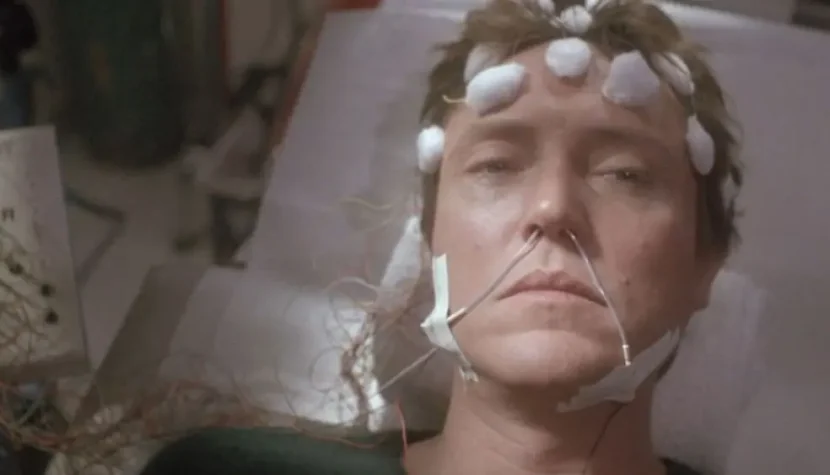COMMUNION: An Underrated Sci-Fi Film or Nonsensical Farce?

Christopher Walken is abducted by a UFO, meets his doppelgänger, and dances with aliens who insert an anal probe into him. Despite appearances, Communion is not a comedy.
American writer Whitley Strieber lives in a comfortable Manhattan apartment with his wife Anne and their young son Andrew. To overcome a creative block, Whitley takes his family and a couple of friends on a weekend trip to a secluded cabin in the woods. On the very first night, strange things start happening: first, the burglar alarm goes off, then a blinding light appears, and Whitley sees a figure inside the house. The incident is so disturbing that the next day everyone decides to cut the trip short and return to New York. A few weeks later, Whitley, Anne, and Andrew return to the cabin to spend Christmas there, but the visit is again disrupted by inexplicable phenomena. Whitley is abducted by aliens and taken aboard a spaceship, where he undergoes experiments. Struggling to cope with the trauma, which destabilizes both his family life and career, the writer begins therapy.
Whitley Strieber began his literary career with bestselling horror novels Wolfen (1978) and The Hunger (1981), both of which were adapted into films: Wolfen (1981) by Michael Wadleigh and The Hunger (1983) by Tony Scott. In 1987, Strieber published a book titled Communion: A True Story, in which he described his alleged encounters with aliens. He referred to them as “visitors” because he wasn’t certain whether they were extraterrestrials, demons, or other beings. Although the book is categorized as non-fiction, there’s no consensus regarding its content: some believe every word Strieber wrote, while others point out that the author has a history of bending the truth—such as claiming to have witnessed the 1966 University of Texas massacre, later recanting, and then returning to his original account (he discusses this in Communion as well).

Communion spent six months on the U.S. bestseller lists, so it’s no surprise that filmmakers approached Strieber about adapting it. Allegedly, Steven Spielberg himself expressed interest, but Strieber rejected his offer and instead collaborated with his friend Philippe Mora—a French-Australian director whose controversial 1973 documentary Swastika nearly caused riots at the Cannes Film Festival. Mora and Strieber, making his debut as a screenwriter, agreed on their working arrangement: the director would not interfere with the script, and the screenwriter would not meddle with the direction. The film secured Christopher Walken, Lindsay Crouse, and Frances Sternhagen for the lead roles, with Eric Clapton composing the main theme. Communion premiered in U.S. theaters in November 1989, flopped at the box office, and received negative reviews—even from Strieber, who disliked how he was portrayed.
On set, Strieber reportedly told Walken that he was portraying him as too insane, to which Walken allegedly replied with something along the lines of, “If you join the crows…” Mora admitted to giving Walken complete creative freedom in portraying Strieber, allowing him to improvise, pull faces, and dance with aliens. As a result, Strieber’s character became pure Walken, with his mannered (not a criticism!) acting style full of peculiar quirks, gestures, and grimaces. A quick look at video interviews with the real Strieber reveals that the writer has little in common with Walken’s portrayal. However, this discrepancy seems intentional, especially when paired with another element of Communion: its special effects. The aliens in Mora’s film look fake even by 1980s standards: some resemble small, blue offspring of Jabba the Hutt from Star Wars, while others adhere to the typical “grey alien” template with elongated faces and large black eyes.

The alien designs were so cheesy that Walken reportedly burst into genuine laughter upon seeing them (Mora liked his reaction so much that he kept it in the film). The total budget for Communion was $7 million—roughly $18 million today—enough to afford convincing costumes and makeup. So perhaps the artificiality was deliberate? Maybe the puppet-theater-like quality, along with Walken’s exaggerated performance, was intended to suggest that the story is a product of the protagonist’s imagination—a symptom of mental illness, a dream, a hallucination, or a delusion. (The film’s atmosphere is indeed dreamlike, evoking a nightmare or a David Lynch-esque vision.) Mora provides no definitive answers, much like Strieber’s book, in which the author himself seems unsure of what truly happened to him.
All of this makes Communion a thought-provoking, ambiguous, and very difficult film to judge. It’s impossible to determine whether it’s sophisticated satire or a sincere take on the subject—and if the latter, what exactly is the subject? Mental health cloaked in the metaphor of alien abduction? Or the abduction phenomenon itself, which has fascinated pop culture at least since the case of Barney and Betty Hill? Are the filmmakers mocking New Age obsessions with extraterrestrial civilizations, or are they cynically exploiting and fueling them? Is this an underappreciated science fiction film misunderstood by critics and audiences, or is it a nonsensical farce? The verdict, as always, lies with the individual viewer. Regardless of Mora and Strieber’s intentions, one thing is certain: Communion is a remarkable and unique production, a true oddity among science fiction films—and for that alone, it’s worth watching this strange, somewhat forgotten movie.

